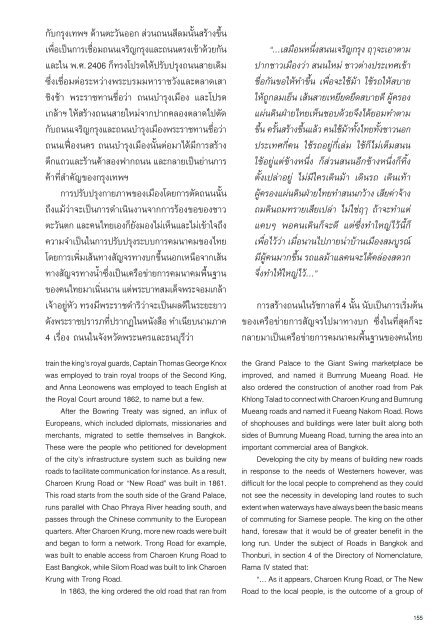บ้านเรือนถิ่นไทยในช่วงเจ็ดทศวรรษ 2489-2559
Create successful ePaper yourself
Turn your PDF publications into a flip-book with our unique Google optimized e-Paper software.
กับกรุงเทพฯ ด้านตะวันออก ส่วนถนนสีลมนั้นสร้างขึ้น<br />
เพื่อเป็นการเชื่อมถนนเจริญกรุงและถนนตรงเข้าด้วยกัน<br />
และใน พ.ศ. 2406 ก็ทรงโปรดให้ปรับปรุงถนนสายเดิม<br />
ซึ่งเชื่อมต่อระหว่างพระบรมมหาราชวังและตลาดเสา<br />
ชิงช้า พระราชทานชื่อว่า ถนนบำรุงเมือง และโปรด<br />
เกล้าฯ ให้สร้างถนนสายใหม่จากปากคลองตลาดไปตัด<br />
กับถนนเจริญกรุงและถนนบำรุงเมืองพระราชทานชื่อว่า<br />
ถนนเฟื่องนคร ถนนบำรุงเมืองนั้นต่อมาได้มีการสร้าง<br />
ตึกแถวและร้านค้าสองฟากถนน และกลายเป็นย่านการ<br />
ค้าที่สำคัญของกรุงเทพฯ<br />
การปรับปรุงกายภาพของเมืองโดยการตัดถนนนั้น<br />
ถึงแม้ว่าจะเป็นการดำเนินงานจากการร้องขอของชาว<br />
ตะวันตก และคนไทยเองก็ยังมองไม่เห็นและไม่เข้าใจถึง<br />
ความจำเป็นในการปรับปรุงระบบการคมนาคมของไทย<br />
โดยการเพิ่มเส้นทางสัญจรทางบกขึ้นนอกเหนือจากเส้น<br />
ทางสัญจรทางน้ำซึ่งเป็นเครือข่ายการคมนาคมพื้นฐาน<br />
ของคนไทยมาเนิ่นนาน แต่พระบาทสมเด็จพระจอมเกล้า<br />
เจ้าอยู่หัว ทรงมีพระราชดำริว่าจะเป็นผลดีในระยะยาว<br />
ดังพระราชปรารภที่ปรากฏในหนังสือ ทำเนียบนามภาค<br />
4 เรื่อง ถนนในจังหวัดพระนครและธนบุรีว่า<br />
train the king’s royal guards, Captain Thomas George Knox<br />
was employed to train royal troops of the Second King,<br />
and Anna Leonowens was employed to teach English at<br />
the Royal Court around 1862, to name but a few.<br />
After the Bowring Treaty was signed, an influx of<br />
Europeans, which included diplomats, missionaries and<br />
merchants, migrated to settle themselves in Bangkok.<br />
These were the people who petitioned for development<br />
of the city’s infrastructure system such as building new<br />
roads to facilitate communication for instance. As a result,<br />
Charoen Krung Road or “New Road” was built in 1861.<br />
This road starts from the south side of the Grand Palace,<br />
runs parallel with Chao Phraya River heading south, and<br />
passes through the Chinese community to the European<br />
quarters. After Charoen Krung, more new roads were built<br />
and began to form a network. Trong Road for example,<br />
was built to enable access from Charoen Krung Road to<br />
East Bangkok, while Silom Road was built to link Charoen<br />
Krung with Trong Road.<br />
In 1863, the king ordered the old road that ran from<br />
“...เสมือนหนึ่งสนนเจริญกรุง ฤๅจะเอาตาม<br />
ปากชาวเมืองว่า สนนใหม่ ชาวต่างประเทศเข้า<br />
ชื่อกันขอให้ทำขึ้น เพื่อจะใช้ม้า ใช้รถให้สบาย<br />
ให้ถูกลมเย็น เส้นสายเหยียดยืดสบายดี ผู้ครอง<br />
แผ่นดินฝ่ายไทยเห็นชอบด้วยจึงได้ยอมทำตาม<br />
ขึ้น ครั้นสร้างขึ้นแล้ว คนใช้ม้าทั้งไทยทั้งชาวนอก<br />
ประเทศกี่คน ใช้รถอยู่กี่เล่ม ใช้ก็ไม่เต็มสนน<br />
ใช้อยู่แต่ข้างหนึ่ง ก็ส่วนสนนอีกข้างหนึ่งก็ทิ้ง<br />
ตั้งเปล่าอยู่ ไม่มีใครเดินม้า เดินรถ เดินเท้า<br />
ผู้ครองแผ่นดินฝ่ายไทยทำสนนกว้าง เสียค่าจ้าง<br />
ถมดินถมทรายเสียเปล่า ไม่ใช่ฤๅ ถ้าจะทำแต่<br />
แคบๆ พอคนเดินก็จะดี แต่ซึ่งทำใหญ่ไว้นี้ก็<br />
เพื่อไว้ว่า เมื่อนานไปภายน่าบ้านเมืองสมบูรณ์<br />
มีผู้คนมากขึ้น รถแลม้าแลคนจะได้คล่องสดวก<br />
จึ่งทำให้ใหญ่ไว้...”<br />
การสร้างถนนในรัชกาลที่ 4 นั้น นับเป็นการเริ่มต้น<br />
ของเครือข่ายการสัญจรไปมาทางบก ซึ่งในที่สุดก็จะ<br />
กลายมาเป็นเครือข่ายการคมนาคมพื้นฐานของคนไทย<br />
the Grand Palace to the Giant Swing marketplace be<br />
improved, and named it Bumrung Mueang Road. He<br />
also ordered the construction of another road from Pak<br />
Khlong Talad to connect with Charoen Krung and Bumrung<br />
Mueang roads and named it Fueang Nakorn Road. Rows<br />
of shophouses and buildings were later built along both<br />
sides of Bumrung Mueang Road, turning the area into an<br />
important commercial area of Bangkok.<br />
Developing the city by means of building new roads<br />
in response to the needs of Westerners however, was<br />
difficult for the local people to comprehend as they could<br />
not see the necessity in developing land routes to such<br />
extent when waterways have always been the basic means<br />
of commuting for Siamese people. The king on the other<br />
hand, foresaw that it would be of greater benefit in the<br />
long run. Under the subject of Roads in Bangkok and<br />
Thonburi, in section 4 of the Directory of Nomenclature,<br />
Rama IV stated that:<br />
“... As it appears, Charoen Krung Road, or The New<br />
Road to the local people, is the outcome of a group of<br />
155


















